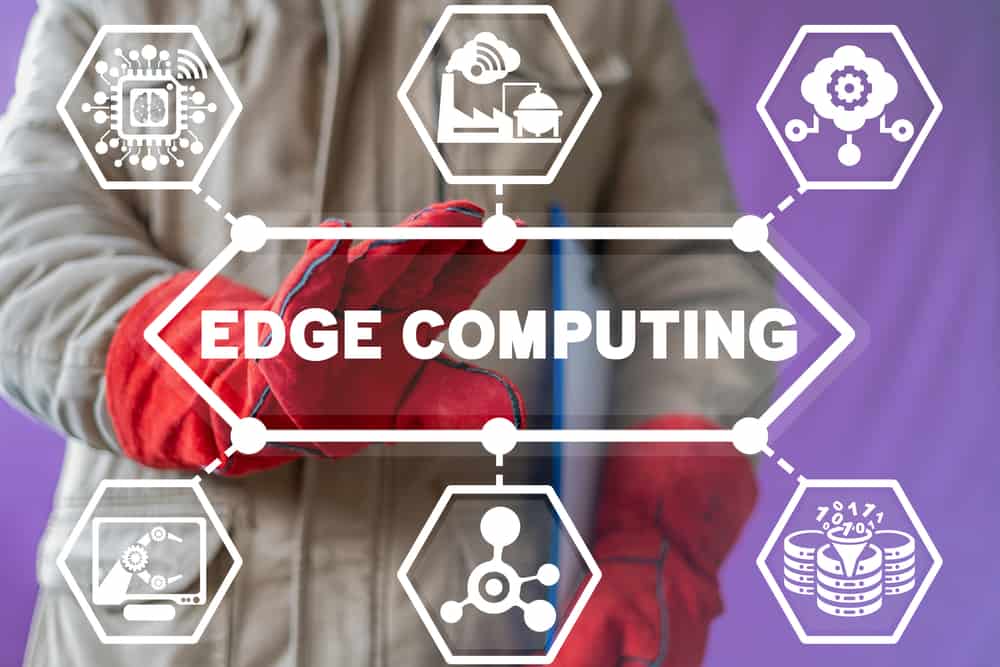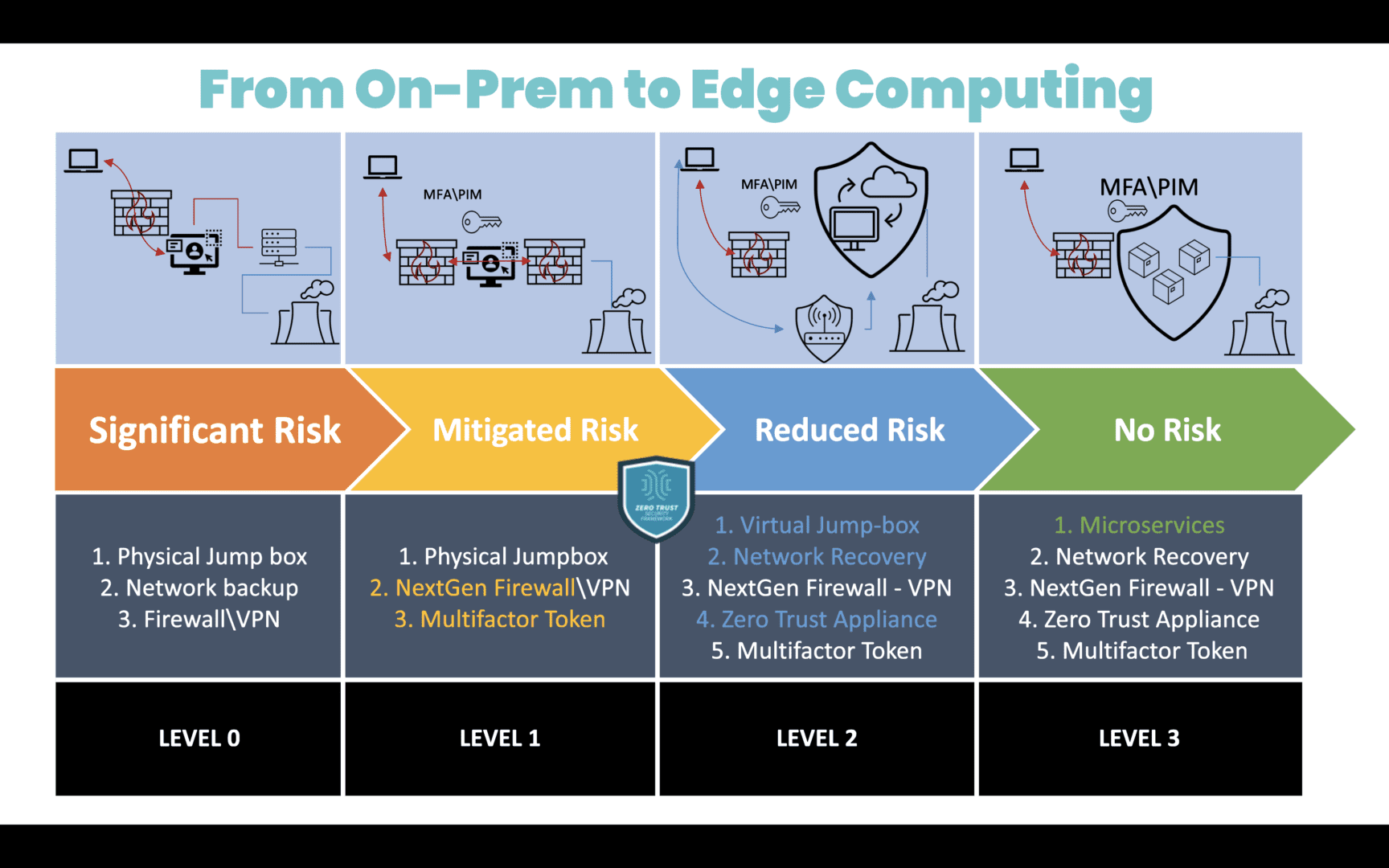
Edge computing supports secure, real-time data analysis by reducing off-site data transmission. Edge native computing also enables the transition to digital transformation 2.0 by allowing companies to do something with their edge data in real-time, not just collect it. This post discusses six different use cases that could benefit from distributed edge computing, including healthcare, finance, energy, manufacturing, utilities/public services, and AI & machine learning.
Jump to the executive summary.
Distributed edge computing use cases

Image: Concrete use case that can work across all industries, showing the migration from on-prem computing to microservices at the edge, along with the associated level of security risk.
Healthcare
The healthcare industry quickly and enthusiastically adopted IoT technology for medical equipment like insulin pumps, pacemakers, and imaging devices to improve patient health monitoring and outcomes. These sensors generate massive quantities of data that healthcare organizations must transmit to applications in central data centers or the cloud for processing. This data can’t be transferred over the open Internet for security and compliance reasons, so it’s usually funneled through a central firewall via MPLS (for branches, clinics, and other physical sites), overlay networks, or SD-WAN (for wearable sensors and mobile EMS devices). The firewall becomes a bottleneck that increases latency and prevents real-time data processing, introducing potentially lethal delays in health monitoring and response.
Distributed edge computing for healthcare involves installing medical data processing applications closer to the sensors and devices generating most of the data. Edge computing occurs on the same local network or even the same onboard chip (using system-on-chip or SoC technology), which reduces security risks and latency. For example, software running on an implanted heart-rate monitor can analyze patient data in real time without a network connection. If it detects any concerning activity that falls outside of an established baseline, it uses multiple cellular and ATT FirstNet connections to send alerts to the cardiologist without exposing any private patient data. Even if the application can’t establish a network connection at all, the device itself can alert the patient that there’s a problem so they can take immediate action.
Another healthcare use case is mobile EMS units processing patient health data en route to the hospital using edge compute resources built into cellular edge routers. Edge native applications can help medics prevent allergic reactions and harmful medication interactions when administering treatment.
Finance
Finance industry networks are typically highly decentralized, using branches, web and mobile applications, and self-service ATMs to make their services accessible to customers around the world. Banks and other institutions know that edge data has value beyond the financial transactions being conducted, so they use data analytics software (often powered by AI & machine learning) to gain insights into how to improve their services and generate more revenue. However, there are enormous security, regulatory, and reputational risks involved in transmitting sensitive financial data, making it challenging to leverage cloud- or data center-based analytics software.
Distributed edge computing moves financial data processing applications to branches and 26remote PoPs (points of presence) to help mitigate the risks of transmitting data off-site. For example, financial institutions can install all-in-one branch gateway services routers with built-in edge compute functionality in networking closets, drive-up kiosks, or even inside an ATM’s housing. Running data analytics software from this device enables real-time data processing for business insights, surveillance, customer service improvements, and more. These routers should also include out-of-band (OOB) management technology to support infrastructure isolation and simplify compliance with PCI DSS 4.0 and other regulations.
Energy
Edge data in the oil and gas industry comes from IoT sensors and automated equipment deployed in remote sites, drilling rigs, and offshore platforms all over the world. Analyzing that data is crucial for productivity, safety, and compliance, but it’s often difficult to maintain a fast and reliable network connection with applications in data centers or the cloud.
Distributed edge computing allows oil and gas companies to effectively harness their data in challenging deployment environments, such as the middle of the ocean. For example, companies can tuck compact, cellular-enabled edge computing devices into maintenance closets or other small compartments to deploy software that analyzes equipment monitoring data, well logs, and borehole logs. This software can provide predictive maintenance recommendations, alert technicians to potential quality or safety issues, and deliver productivity forecasts and insights without requiring an Internet connection.
Manufacturing
Companies across nearly every industry are increasingly automating their manufacturing to improve productivity, lower costs, and reduce errors. To further reduce human involvement, they use software to monitor equipment health, track production costs, schedule preventative maintenance, and perform quality assurance (QA) tasks. This software, which typically runs from the cloud or a centralized data center, relies on data generated by automated operational technology (OT) and other manufacturing machinery. As in the above use cases, transmitting OT back and forth creates latency and security issues. There are additional risks associated with manufacturing operations located overseas, where political instability, disasters, and other external forces could interrupt communications.
Distributed edge computing enables real-time, data-driven insights to improve manufacturing efficiency and elevate product quality. Plus, some edge computing solutions, like the Nodegrid integrated branch services router, provide out-of-band (OOB) management access to remote equipment. OOB management creates a dedicated management network that’s completely isolated from the production network, ensuring continuous remote access to operational technology, monitoring systems, and edge native applications during Internet outages and other adverse events.
Utilities / public services
Many forward-thinking cities are deploying Internet of Things (IoT) devices to improve their utilities and public services and better connect their communities. These “smart cities” collect data from Internet-connected thermostats, parking meters, traffic lights, security cameras, and other devices deployed outdoors, in public facilities, and in citizens’ homes. However, local governments often find it challenging to keep up with fleet management, ensuring all these devices are connected, patched, and up-to-date to prevent breaches and failures.
Distributed edge computing reduces the networking and bandwidth requirements for IoT-enabled utilities, public services, and smart cities. Edge native applications can analyze data on the same sensor or device that generates it, reporting back to a centralized cloud or data center as needed to provide alerts, reports, and visualizations. All-in-one edge networking solutions combine connectivity with compute capabilities and are small enough to fit in utility cabinets, under public benches, or on top of street lights. They provide remote IT teams with easy access to monitor devices, deploy updates, and troubleshoot issues over a reliable, cellular OOB connection. An edge native networking solution should also enable automatic, zero-touch operations to streamline digital fleet management at scale.
AI & machine learning
Artificial intelligence (AI) and machine learning (ML) applications ingest data to train, operate, and make decisions. Much of that data originates at the network’s edges – in fact, there are AI & ML applications for every edge use case and industry listed above. Transmitting vast quantities of data to the cloud or a data center introduces network bottlenecks, latency, and security risks that can prevent organizations from getting the full value out of their AI investment.
Because artificial intelligence is very resource-hungry, edge native computing for AI/ML sometimes looks a little different than in other use cases. A typical edge computing deployment for AI & ML involves racks of high-performance machine learning processing units deployed in edge data centers on the same site as (or very nearby) the devices generating data. This approach works well for large machine-learning workloads occurring in a limited number of deployment sites. A more flexible approach involves using smaller graphics processing units (GPUs) or multi-purpose edge devices to handle individual AI/ML workloads in smaller and more distributed edge deployment sites. These “thin” or “nano” deployments are agile and cost-effective, scaling easily as organizations grow in size and geographic distribution.
Executive summary
- Distributed edge computing for healthcare improves patient health outcomes and data privacy with SoC applications on wearable medical devices and cellular edge routers in mobile EMS units.
- Distributed edge computing for the finance industry provides insights into how to improve services and revenue while helping to mitigate security and regulatory risks with on-site data processing and infrastructure isolation.
- Distributed edge computing helps the energy sector effectively harness critical data from sensors and equipment in challenging deployment environments to improve quality, safety, and productivity.
- Distributed edge computing for manufacturing helps companies process data from automated machinery and operational technology to improve manufacturing efficiency and elevate product quality.
- Distributed edge computing for utilities/public services reduces the networking and fleet management challenges for IoT-enabled utilities, public services, and smart cities with all-in-one edge networking solutions, OOB, and zero-touch operations.
- Distributed edge computing for AI & machine learning uses multi-purpose edge devices to handle individual workloads, improving the agility, scalability, and cost-effectiveness of edge AI/ML.
Distributed edge computing with Nodegrid
Nodegrid is a line of all-in-one edge networking solutions from ZPE Systems. Nodegrid’s vendor-neutral, integrated branch services routers combine edge gateway networking functionality with Gen 3 out-of-band management and edge computing capabilities. The Nodegrid platform streamlines distributed edge computing for any use case with consolidated hardware and software that reduce deployment costs and management headaches while improving efficiency.
See Nodegrid’s edge solutions in action
Nodegrid delivers streamlined, cost-effective solutions for distributed edge computing in healthcare, EMS, financial services, local governments, and more. To see how Nodegrid works for your edge computing use case, request a free demo.
